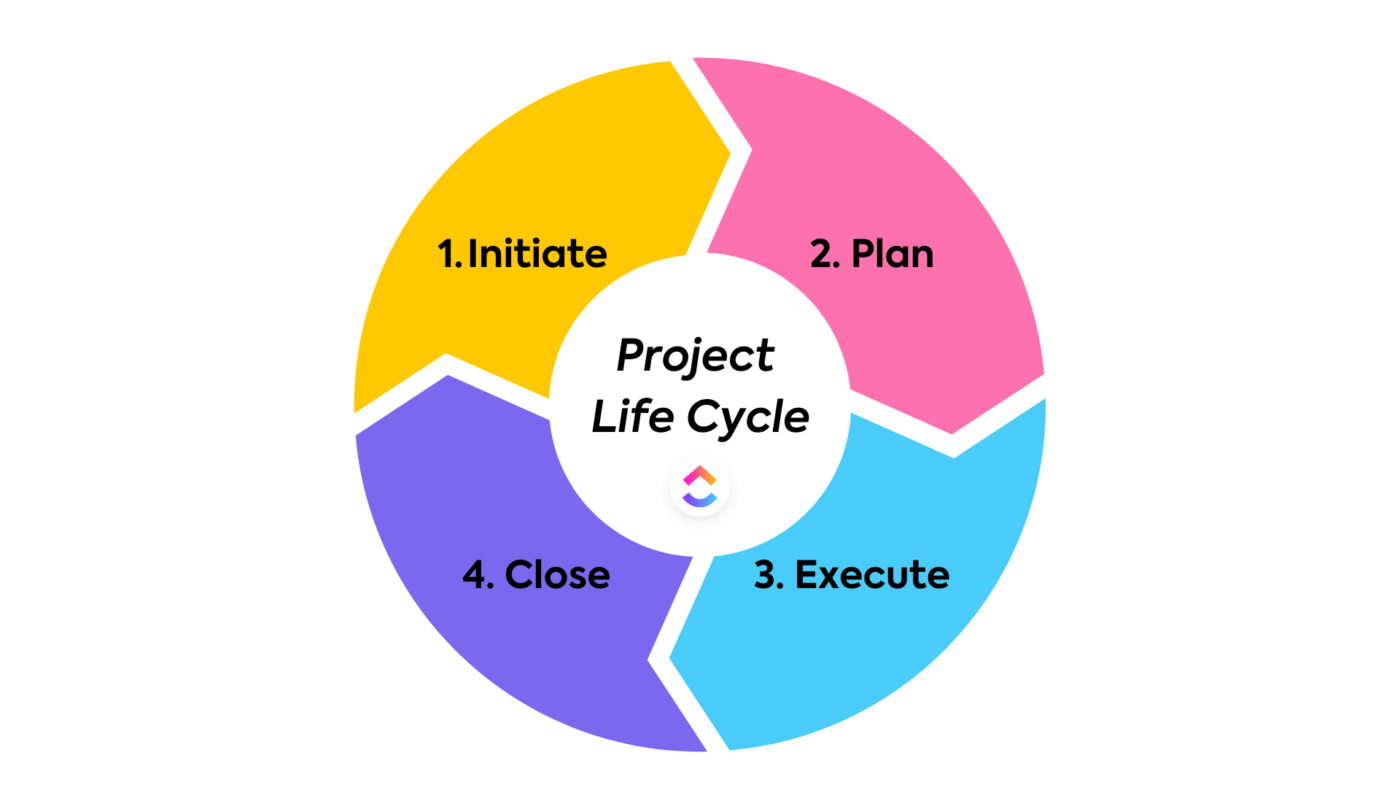سواء كان مشروعًا منزليًا أو مشروعًا تجاريًا، بسيطًا أو معقدًا بطبيعته، فإن الخلطة السرية لتقديم مشاريع ناجحة هي البدء بقوة مع الاستراتيجية وخطة التنفيذ .
يمكنك القيام بذلك (والقيام بذلك بشكل جيد) مع عقلية الانطلاق، وأساليب إدارة المشروع المناسبة، والأدوات المناسبة.
ستتعرف في هذه المقالة على اللبنات الأساسية لإدارة المشاريع، بما في ذلك عوامل النجاح الرئيسية والمراحل، بالإضافة إلى كيفية إدارة المشروع يمكن أن تبقيهم معًا. ثم سنوضح لك كيف يعمل كل ذلك عملياً من خلال خمسة أمثلة حقيقية لإدارة المشاريع! 👌
المراحل الأربع لدورة حياة إدارة المشروع ## المراحل الأربع لدورة حياة إدارة المشروع
يمكن أن تأتي إدارة المشاريع من البداية إلى النهاية مع مراحل طويلة و عمليات معقدة . لذا، للمساعدة في تسهيل مهمة الجميع، فإن مفهوم دورة حياة المشروع تم تقديمها.

عبر ClickUp
تتكون دورة حياة المشروع، أو عملية إدارة المشروع، من أربع مراحل: البدء والتخطيط والتنفيذ والإغلاق. إنها مسار منظم تمر به مشاريعك للمساعدة في نقلها من مرحلة التصور إلى مرحلة الإنجاز وضمان أهداف المشروع يتم تسليمها في كل مرحلة.
دعونا نلقي نظرة على ما هو مسؤول عنه مدير المشروع في كل مرحلة:
1. مرحلة البدء
إشراك الجميع. يحدد مدير المشروع هدف المؤسسة أو العميل أو الزبون ويحدد أصحاب المصلحة الرئيسيين وفريق المشروع و نطاق عمل المشروع ويحدد الأهداف القابلة للقياس للفريق
2. مرحلة التخطيط
الإعداد الاستراتيجي للمشروع ورسم خريطة له. يكون مدير المشروع مسؤولاً عن إنشاء خطة مفصلة للمشروع وتحدد الجدول الزمني للمشروع الذي يتضمن الجدول الزمني الرئيسي المعالم الرئيسية للمشروع ويصف المهام أو المنجزات تشكل كل مرحلة من مراحل المشروع. وهذا أمر مهم لأن خطة المشروع توفر استراتيجية و قائمة مراجعة المشروع للمساعدة في إدارة الموارد والميزانية والجدول الزمني بشكل صحيح على طول دورة حياة المشروع.
3. مرحلة التنفيذ
حان وقت التنفيذ. في هذه المرحلة، تتمثل المهمة الرئيسية لمدير المشروع في الإشراف على جهود الفريق والتأكد من فهم الجميع لما هو متوقع منهم، وما هي المهام التي يجب القيام بها، وكيفية وتوقيت إنجاز تلك المهام لضمان إنجاز كل شيء ضمن الجدول الزمني للمشروع.
4. المرحلة الختامية
حان وقت اختتام المشروع. يجب على مدير المشروع تحديد أن فريقه قد أكمل جميع النتائج المطلوبة، ثم تقديم المنتج النهائي إلى أصحاب المصلحة للتوقيع عليه وإغلاق المشروع رسميًا.
📌 📌الخلاصة الرئيسية:
باتباعك لدورة حياة المشروع، فإنك تضمن أنك
- تحقيق توقعات عميلك
- تحديدالمشروع للنجاح من خلال خطة
- تنفيذ مهام المشروع ومعالجة أي مشاكل أو مخاطر المشروع التي تنشأ
- إغلاق مشروعك لالتقاطأي دروس مستفادة وتحسين المشاريع القادمة
هل تريد اكتساب ميزة استراتيجية؟ تعرّف على كيفية استخدام الذكاء الاصطناعي لإدارة المشاريع. 👇🏼
العوامل الرئيسية للإدارة الناجحة للمشاريع ## العوامل الرئيسية لإدارة المشاريع الناجحة
يمكن أن تختلف العوامل الحاسمة للإدارة الناجحة للمشروع من مشروع إلى آخر، ولكن إليك بعض العوامل التي يجب أن تظل ثابتة بغض النظر عن نوع المشروع أو الصناعة التي تعمل فيها:
✅ تعيين الأهداف الذكية ✅ فهم نطاق المشروع ومنع زحف النطاق
✅ تحديد مخاطر المشروع وإنشاء خطة لإدارة المخاطر
✅ تحديد الأدوار والمسؤوليات بوضوح
✅ التواصل الفعال للفريق
✅ الحفاظ على مستوى عالٍ من الوضوح في المشروع
كيف تمنح برمجيات إدارة المشاريع فرق العمل المرونة
في ظل وجود العديد من العوامل التي يمكن أن تؤثر على نجاح المشروع، فإن استخدام برنامج إدارة المشاريع يمكن أن يساعد في إبقاء الجميع وكل شيء على المسار الصحيح وقبل حدوث أي عقبات.
جيد تطبيق إدارة المشاريع يمكن أن يزيح الكثير من عبء إدارة المشاريع عن عاتقك من خلال تزويد الفرق بالأدوات التي يحتاجونها للحصول على نظرة عامة عالية المستوى لعملهم، وتبسيط عمليات الأعمال، وإنشاء تدفقات عمل فعالة، والتواصل بشكل أكثر فعالية، وجعل التعاون سلسًا وأكثر متعة. كليك أب يساعد مديري المشاريع وفرق العمل على تخطيط المشاريع وإدارتها وتتبعها والتعاون مع بعضهم البعض - كل ذلك في مكان واحد. وتوفر منصته القابلة للتخصيص بالكامل للفرق المرونة والأدوات المتقدمة التي يحتاجون إليها لإنشاء سير العمل الأكثر كفاءة الذي يناسب احتياجات وتفضيلات المشروع.
ونظرًا لأن المنصة قابلة للتخصيص بالكامل، فإن الفرق في ClickUp مجهزة بالكامل للتعامل مع أي نوع من المشاريع ودعم أي نوع من منهجية إدارة المشروع ، بما في ذلك المناهج الأكثر شيوعًا مثل Waterfall وAgile (Scrum وKanban) وLean وSigma Six Sigma وغيرها.
مراقبة تحديثات المشروع
وإدارة المخاطر، والعمل مع الفريق، كل ذلك من مساحة عمل ClickUp الخاصة بك
تتضمن ميزات ClickUp الرئيسية لإدارة المشروع بفعالية ما يلي:
- طريقة عرض قابلة للتخصيص: اعرض مشاريعك بطريقتك الخاصة؛ اختر من بين أكثر من 15 طريقة عرض، بما في ذلك مخطط جانت، والجدول الزمني، وعرض عبء العمل
- أتمتة مخصصة: وفّر الوقت وحافظ على اتساق عملياتك وتبسيط سير عملك
- حالات المهام المخصصة: إضافة وتعيين مراحل مختلفة إلى مهامك لتحسين رؤية المشروع
- حقول مخصصة: إضافة المزيد من السياق إلى مهامك وعرض المعلومات المهمة
- الأهداف: ابقَ على المسار الصحيح لتحقيق أهداف SMART الخاصة بك مع جداول زمنية واضحة وأهداف قابلة للقياس وتتبع التقدم التلقائي
- معالم المشروع: معالم المشروع: قم بتعيين المعالم الرئيسية بسهولة لمساعدتك على البقاء على رأس المواعيد النهائية المهمة وتتبع تقدم فريقك مقابل نقاط التفتيش الرئيسية
- التبعيات: أضف تبعيات "الحجب" أو "الانتظار" بين المهام لتعيين ترتيب واضح للعمليات، بحيث يعرف فريقك دائمًا ما يجب العمل عليه أولاً
- قائمة مراجعة المهام: قم بإنشاء قائمة مهام داخل كل مهمة لضمان إكمال جميع الخطوات قبل المضي قدمًا في المهمة
- لوحات المعلومات: أنشئ مركزًا للتحكم في المهام لكل مشروع وعضو في الفريق وغير ذلك لضمان أن كلأصحاب المصلحة في المشروع لديه المعلومات التي يحتاجها للتحكم في أي مخاطر للمشروع والحفاظ على تسليم المشروع ضمن جدوله الزمني
- تتبع الوقت العالمي: تتبع الوقت المستغرق في المهام، ووضع التقديرات، وإضافة الملاحظات، وعرض تقارير عن وقتك من أي مكان
- تعليقات مخصصة: إنشاء وتعيينعناصر العمل مباشرة ضمن تعليق
- تطبيق الهاتف المحمول : حافظ على إمكانية الوصول إلى مشاريعك أينما ذهبت باستخدام تطبيق ClickUp للجوال
- التكامل : قم بتوصيل ClickUp بأكثر من 1,000 أداة من أدوات العمل المفضلة لديك لتبسيط سير عملك
عرض القائمة الكاملة لميزات ClickUp
_الآن، دعنا نلقي نظرة على بعض الأمثلة الواقعية لإدارة المشاريع ونتعرف على كيفية نجاح خبراء آخرين في هذا المجال في إنجاز المشاريع باستخدام المنهجية والأدوات الصحيحة!
5 أمثلة ونصائح لإدارة المشاريع من أجل تسليم المشاريع بنجاح
1. مثال على مشروع تسويقي: إنشاء سير عمل متعدد الوظائف جاكوب جراجار مدير تسويق في STX Next، يقود فريقاً من المتخصصين في المحتوى ووسائل التواصل الاجتماعي، ويقود استراتيجية قسم التسويق في قسم التسويق لتوليد العملاء المحتملين والتعريف بالعلامة التجارية ويعمل مع أقسام متعددة لتنفيذ المشاريع. يتضمن اليوم النموذجي للفريق تنفيذ ما يزيد عن خمسة مشاريع محتوى يتم تسليمها، وغالباً ما يراجع جاكوب أكثر من 10 مشاريع مختلفة في وقت واحد.
المشكلة؟
العمل مع تصميم المنتج كان القسم عملية فوضوية. عانت فرقنا في التواصل لأننا كنا نفتقر إلى رؤية المشروع - لم يكن لدينا في كثير من الأحيان معلومات واضحة حول ما إذا كانت المهام لا تزال قيد المراجعة أو تحتاج إلى مزيد من العمل.
كنا بحاجة ماسة إلى نظام يسمح لي ولرئيس قسم تصميم المنتجات بالحصول على نظرة عامة على العملية بأكملها والإلمام بجميع الأعمال الجارية والمهام القادمة.

جاكوب جراجكار، مدير التسويق في STX Next
الهدف؟ المساعدة في تحسين التعاون العالمي عبر الأقسام وعمليات تسويق المحتوى، وتسريع إنجاز المشروع وتسليمه، والحفاظ على توافق الفرق على الأهداف والجداول الزمنية للمشروع وما إلى ذلك من خلال إنشاء سير عمل متعدد الوظائف وتوحيد العمليات في ClickUp.
إليك كيفية تنفيذ جاكوب وفريقه لهذه المبادرة:
مرحلة البدء #### مرحلة البدء
- تحديد المشروع: إنشاء نماذج سباقات التسويق السريع ولوحات معلومات الفريق
- تحديد النتيجة المرجوة: إدارة مشاريع متعددة، وتبسيط التواصل مع الشركاء، وتسريع عملية إنتاج المحتوى
مرحلة التخطيط
- منهجية إدارة المشروع: رشيق
مرحلة التنفيذ
قائمة مراجعة المهام:
- إعدادالتسلسل الهرمي في ClickUp
- إنشاء مجلدات لكل قسم وإعداد قوائم داخل كل مجلد
- داخل كل قائمة، قم بإنشاء مهام ومهام فرعية لتقسيم العمل بشكل أكبر
- حفظ المهام كقالب يمكن إعادة استخدامها عدة مرات حسب الحاجة
- إنشاء مجلدات لكل قسم وإعداد قوائم داخل كل مجلد
- قم بإعداد حالات المهام المخصصة لإعطاء كل مرحلة من مراحل المشروع اسمًا معينًا
- إضافة حقول مخصصة إلى كل قائمة لعرض المعلومات الأساسية والحفاظ على سهولة الوصول إليها
- إضافة أتمتة مخصصة لتشغيل إجراء ما تلقائيًا ودفع المشروع إلى الخطوة التالية
- حفظ المجلد كقالب ليتم إعادة استخدامه في سبرينت التالي وللحفاظ على اتساق العمليات
- إنشاء لوحة معلومات مخصصة مع تقارير في الوقت الفعلي لعرض البيانات الرئيسية وتحسين رؤية المهام
مرحلة الإغلاق
- في نهاية المشروع، قام جاكوب وفرق العمل في STX Next باختبار قالب سباقات التسويق الجديدة ولوحة المعلومات للتأكد من سلاسة العملية لجميع المشاركين في المشروع وإعداد جميع الأتمتة المخصصة في ClickUp بشكل صحيح.
📌 استخدم هذا قالب مجلد التسويق السريع للمساعدة في تخطيط المشروع، والحفاظ على أنشطة المشروع مرئية ومنظمة، وتبسيط عملياتك. ابدأ العمل مع طرق عرض اللوحة والقائمة المحددة مسبقًا، وإمكانيات تقدير المهام، والأتمتة القابلة للتخصيص!
قم بتنزيل قالب مجلد مجلد سباقات التسويق السريع من جاكوب
2. مثال على مشروع تحسين محركات البحث: توسيع نطاق إنتاج المحتوى أديل بايانت ، أخصائية تحسين محركات البحث في ClickUp، مسؤولة عن البحث عن الفرص المتاحة وإنشاء ملخصات محتوى للكتاب لاستخدامها كدليل عند صياغة المقالات لصفحة المدونة. ولكتابة ملخصات محتوى مقنعة، عليها إجراء بحث عن الكلمات الرئيسية,
تحليل تنافسي وغيرها من المهام المهمة ذات الصلة، والتأكد من أن موجز المحتوى مفصّل وسهل المتابعة بالنسبة للكتّاب.
المشكلة؟
كان التحدي الأكبر في سير عمل مدونات تحسين محركات البحث لدينا هو التركيز على توسيع نطاق إنتاج المحتوى دون التأثير على جودة كل مدونة.

أديل بايانت، أخصائية تحسين محركات البحث في ClickUp
الهدف؟
إنشاء نظام واضح وقابل للتكرار لمساعدة فريق تحسين محركات البحث لدينا على زيادة حجم الملخصات دون المساس بجودة الملخص وتقليل التواصل غير الضروري ذهاباً وإياباً.
إليك كيفية تنفيذ أديل لهذا المشروع:
مرحلة البدء #### مرحلة البدء
- تحديد المشروع: إنشاء نموذج تفصيلي ومنظم لموجز محتوى تحسين محركات البحث
- تحديد النتيجة المرجوة: إنشاء سير عمل منظم ومتسق للبحث وإنشاء ملخصات المحتوى، وتسريع عملية الموافقة
مرحلة التخطيط
- منهجية إدارة المشروع: رشيقة
مرحلة التنفيذ
قائمة مراجعة المهام:
- تواصل مع فريق الكتابة للحصول على ملاحظات حول العملية الحالية
- إنشاءمدونة تحسين محركات البحث قائمة مرجعية فيمستندات ClickUp
- ابدأ مستندًا جديدًا واستخدم أدوات التحرير الغنية لتنظيم صفحتك
- أضف عناوين لتحديد الأقسام في مستندك بوضوح
- تضمين روابط لأمثلة على المقالات والبيانات الرئيسية الأخرى من البحث عن الكلمات الرئيسية
- أضف صفحات متداخلة لالتقاط الملاحظات ليقوم الكاتب المعين بمراجعتها قبل صياغة المقال
- احفظ المستند كقالب
- ابدأ مستندًا جديدًا واستخدم أدوات التحرير الغنية لتنظيم صفحتك
مرحلة الإغلاق
- لضمان أن يكون موجز مدونة المحتوى مطابقًا للمعايير المطلوبة، قام مدير تحسين محركات البحث وأخصائي تحسين محركات البحث ومديري المحتوى بمراجعة المستند وتقديم النموذج إلى كتّاب المحتوى لمراجعته للتأكد من سهولة قراءته وجمع الملاحظات. يتم إغلاق المشروع رسمياً بعد موافقة جميع أصحاب المصلحة عليه.
📌استخدم هذا قالب موجز محتوى تحسين محركات البحث لبيان أهدافك وغاياتك بوضوح، ومشاركته مع كتّابك لتحسين تقديم المحتوى.
قم بتنزيل قالب موجز محتوى تحسين محركات البحث من ClickUp
لمزيد من النصائح حول إدارة مشاريع تحسين محركات البحث، اطلع على مقالة مدير تحسين محركات البحث في ClickUp: نصائح لتحسين سير عملك .
3. مشروع تمكين العملاء: إطلاق برنامج جديد روبن ويزنر مسؤول نظام إدارة التعلم في ClickUp، وهو مسؤول عن تقديم مبادرة جديدة لمنح عملاء ClickUp طريقة ممتعة وتفاعلية لتعلم كيفية استخدام ClickUp وتعظيم الميزات داخل المنصة.
وقد أطلق فريق تمكين العملاء، الذي يعمل روبن عضوًا فيه، مبادرة "تمكين العملاء جامعة ClickUp (CUU) في نوفمبر 2021\. وقد لاقى البرنامج الجديد استجابة إيجابية للغاية من مستخدمي ClickUp، مما أعطى الفريق في نهاية المطاف الضوء الأخضر لإطلاق خيار آخر للمساعدة في تعزيز تجربة المستخدم.
ولتحقيق ذلك، قادت مبادرة إطلاق شهادات CUUU - وهو برنامج يهدف إلى تقدير معرفة مستخدمي ClickUp بالمنتج ومكافأتهم على إكمال اختبارات الدورة التدريبية.
المشكلة؟
كان التحدي الأكبر لمشروع بهذا الحجم هو الإدارة عبر العديد من الفرق ذات الأولويات المتنافسة .

روبن ويزنر، مسؤول نظام إدارة التعلم الآلي، تمكين العملاء في ClickUp
الهدف؟
أن تفويض العمل بفعالية وإطلاق برنامج الاعتماد الجديد في الوقت المحدد لتوفير عملية قابلة للقياس للعملاء من أجل تأهيلهم بنجاح وتعزيز تجربتهم كمستخدمين لـ ClickUp.
إليك كيفية قيام روبن وأعضاء فريق المشروع بتحقيق ذلك:
مرحلة البدء
- تحديد المشروع: إطلاق برنامج الاعتماد الجديد والترويج له
- تحديد النتيجة المرجوة: التعاون مع فرق مختلفة لتصميم وإطلاق برنامج الاعتماد الجديد.
مرحلة التخطيط
- منهجية إدارة المشروع: منهجية إدارة المشروع: الشلال
مرحلة التنفيذ
قائمة مراجعة المهام:
- تحديد الأهداف لكل مستوى من مستويات الشهادات والدورات التدريبية في ClickUp Docs
- تطوير مجموعة الاختبار التجريبي وإجراءات التشغيل الموحدة للاختبار في ClickUp Docs
- حدد الخطوط العريضة لتصنيف الرسم البياني ورحلة العميل في ClickUp Whiteboards
- إنشاء مهام ClickUp لتطوير المحتوى وإسنادها إلى أعضاء الفريق المعينينين
- استخدامنموذج ClickUp لتقديم طلب تصميم للشهادات
- تقديم طلب لإنشاءمقالة نظرة عامة على مركز المساعدة
- التعاون مع فريق عمليات التطوير لترميز وإدارة تصميم الموقع الإلكتروني
- إجراء الاختبارات مع مجموعة الاختبار التجريبي وجمع الملاحظات
- التعاون مع فريق عمليات التطوير لترميز وإدارة تصميم الموقع الإلكتروني
- إنشاء مواد التمكين الداخلية والخارجية
- تقديم طلب مواد ترويجية تسويقية
مرحلة الإغلاق
- لإنهاء هذا المشروع وإغلاقه، فإنأصحاب المصلحة في المشروع مراجعة التصاميم الإبداعية واختبار أداء الموقع الإلكتروني وتجربة المستخدم. تم منح الموافقة بمجردمتطلبات المشروع تم استيفاؤها.
📌استخدم هذا قالب نموذج الملاحظات لتخصيص مجموعة ملاحظاتك، وعرض جميع ملاحظاتك في مكان واحد، وتحسين منتجاتك وخدماتك.
قم بتنزيل قالب نموذج الملاحظات من ClickUp
مكافأة:_
_/مرجع/ https://clickup.com/blog/project-management-software-for-freelancers// برنامج إدارة المشاريع للعاملين لحسابهم الخاص %/%href/_
4. مثال على مشروع تعليمي: بناء لوحات معلومات لإعداد تقارير البيانات على مستوى الشركة موري غراهام مدير خدمات الخريجين والمتبرعين (ADS) في جامعة ويك فورست، يقود و
يدير حملات جمع التبرعات وعلاقات الخريجين وهوية العلامة التجارية والمنشورات داخل مجتمع ويك فورست.
المشكلة؟
نظرًا لأن الفرق كانت تعمل على منصات منفصلة، فقد أدى ذلك إلى خلق صوامع عمل أدت إلى ازدواجية الجهود وضعف التواصل بين الفرق. كما كنا نفتقر إلى رؤية بياناتنا مما أثر على قدرتنا على اتخاذ قرارات عمل قوية للمؤسسة.

موري غراهام، مدير خدمات الخريجين والمتبرعين في جامعة ويك فورست
الهدف؟
العثور على أداة إدارة المشروع سهلة الاستخدام لجميع الأقسام، وإنشاء لوحة تحكم للأعمال تعرض البيانات وتحديثها في الوقت الفعلي للمساعدة في تحسين رؤية المشروع عبر المؤسسة.
إليك كيفية قيام موري وقسم خدمات الدعم الإداري بتنفيذ هذا المشروع:
مرحلة البدء #### مرحلة البدء
- تحديد المشروع: إنشاء ملف دقيق وموثوق بهلوحة معلومات المشروع للقيادة وأعضاء الفريق
- تحديد النتيجة المرجوة: تحسين الإبلاغ عن البيانات ورؤية المهام عبر الأقسام، ومواءمة أهداف الفريق
مرحلة التخطيط
- منهجية إدارة المشاريع: رشيقة
مرحلة التنفيذ
قائمة مراجعة المهام
- توحيد أدوات العمل ودمج التطبيقات معًا لتبسيط عملية إعداد تقارير البيانات
- تعييناجتماع لجميع الموظفين مع الإدارة لجمع الملاحظات حول العملية الحالية وتوثيق ملاحظات الاجتماعات في مستند أوالمفكرة
- قم بإعداد مساحة العمل الخاصة بك وإنشاء مقر مخصص لكل قسم
- قم بإنشاء مساحة لكل قسم لتنظيم العمل حسب الأقسام
- داخل كل مساحة، أنشئ مجلدًا لكل مشروع داخل كل مساحة
- داخل كل مجلد، قم بإنشاء قائمة لكل عضو من أعضاء الفريق
- قم بإعداد مساحة العمل الخاصة بك وإنشاء مقر مخصص لكل قسم
- تخصيص طرق عرض مشروعك وإضافة معلومات أساسية لكل مهمة
- إنشاء حالات مخصصة لكل مرحلة من مراحل المشروع
- قم بإعداد علامات وإضافتها إلى المهام لتصنيف المهام ذات الصلة وربطها معًا
- وضع الأهداف وتوثيق الأهداف لكل منها فيانقر فوق الأهداف
- إنشاء لوحة متابعة مخصصة للمؤسسة بأكملها، ولكل قسم ومشروع
- حدد جمهور لوحة المعلومات وقصة البيانات الخاصة بك
- اختر مؤشرات الأداء الرئيسية المناسبة لدعم قصة البيانات
- حدد الأداة التي تطابق متطلبات إعداد التقارير الخاصة بك
- إنشاء لوحة متابعة مخصصة للمؤسسة بأكملها، ولكل قسم ومشروع
مرحلة الإغلاق
- عرض المشروع على رئيس القسم وأصحاب المصلحة الرئيسيين لمراجعته والموافقة عليه لإغلاق المشروع.
📌أنشئ لوحات معلومات مخصصة في ClickUp للحصول على نظرة عامة عالية المستوى لجميع مبادراتك، وأبرز مؤشرات الأداء الرئيسية وحالة المشروع والتقدم المحرز، لإبقاء الجميع على المسار الصحيح والمواءمة في جميع الأوقات.
جرّب خاصية لوحة المتابعة في ClickUp
5. مثال على مشروع إطلاق المنتج: إطلاق ميزة منتج جديد
لتوسيع نطاق قائمة ميزات ClickUp لإدارة المشاريع، قامت الشركة بمبادرة ضخمة لبناء ميزة منتج جديد وإطلاقها بنجاح, ClickUp Whiteboards . يقود المشروع مدير منتجات المجموعة في ClickUp, زاك بلودجيت .
تمثّلت رؤية الشركة في إنشاء أداة تعاون رقمية قوية وسهلة الاستخدام في الوقت نفسه يمكن لمديري المشاريع والمديرين التنفيذيين وأعضاء الفريق استخدامها لرفع مستوى عمليات العصف الذهني والتخطيط والتنفيذ.
المشكلة؟
كان التحدي الأكبر هو حجم الفريق واقتراب الموعد النهائي بسرعة. كان الموعد النهائي ثابتًا وكان لدينا عدد كبير من أصحاب المصلحة من إدارة التسويق والمبيعات والتسعير والتغليف والنمو والدعم ومديري خدمات الدعم وإدارة الدعم المؤسسي وتطوير المنتج. كان علينا أن نتأكد من أنهم كانوا على علم بما سيصدر، وما هو التالي، وكيفية التحدث عن اللوحات البيضاء.

زاك بلودجيت، مدير منتجات المجموعة، إدارة العمل في ClickUp
الهدف؟
استخدام أداة إدارة المشروع للمساعدة في إدارة المهام والتواصل مع أصحاب المصلحة في جميع أنحاء العالم وتقليل المخاطر والعقبات إلى أدنى حد ممكن لتقديم ميزة المنتج الجديدة التي طال انتظارها ضمن الجدول الزمني المتفق عليه.
إليك كيف أطلق زاك والشركة إطلاق مشروع ناجح:
مرحلة البدء
- تحديد المشروع: إطلاق ميزة جديدة
- تحديد النتيجة المرجوة: تقديم ميزة جديدة متجاوبة وعملية بنجاح وإنشاء حملات إدارة التسويق والإعلانات (GTM) ليوم الإطلاق
مرحلة التخطيط
- منهجية إدارة المشروع: منهجية إدارة المشروع: الليّن
مرحلة التنفيذ
قائمة مراجعة المهام:
- قم بتفويض المهام إلى أعضاء الفريق المعني داخل فريق المنتج والهندسة
- استخدمتكامل ClickUp-Github لمعاينة الفروع التي تم ملؤها في المهام
- إنشاءقص مقاطع الفيديو للإبلاغ عن الأخطاء أثناء التطوير ونقل المشكلات المعقدة بسهولة إلى الفرق الأخرى
- التواصل مع فريق الإبداع لتصوير مقاطع الفيديو والإعلانات الترويجية
- التواصل مع الشركة بأكملها لإجراء الاختبارات التجريبية وجمع التعليقات
- إجراء الاختبارات مع فريق الأمان
- التعاون مع المبيعات لتحديد نموذج التسعير
- العمل معتسويق المنتج فريق GTM لإنشاءحملة تسويقية خطة للإطلاق
- تحديد المعالم المهمة والجدول الزمني للإصدار التجريبي
مرحلة الإغلاق
- قام المدير التنفيذي ونائب الرئيس التنفيذي قام نائب الرئيس التنفيذي للهندسة وغيره من أصحاب المصلحة الرئيسيين في المشروع بمراجعة ميزة المنتج، ووافقوا على المنتج النهائي قبل يوم الإطلاق.
إليكم الشكل النهائي - تحققوا من ذلك!
📌ضع منهجًا تفصيليًا لكيفية طرح مؤسستك للمنتج في السوق، واستخدم هذا الانتقال إلى نموذج استراتيجية السوق لمساعدتك في الشحن بشكل أسرع!
تحميل قالب استراتيجية الذهاب إلى السوق من كليك أب
تعامل مع أي مشروع بثقة باستخدام ClickUp
تبدأ الإدارة الناجحة للمشروع بفهم الهدف النهائي للمشروع، وفهم العناصر الرئيسية التي تدخل في خطة مشروع ذكية، ووضع استراتيجية سلسة وقابلة للتنفيذ للوصول إلى هناك - راجع أمثلة إدارة المشروع أعلاه للمساعدة في إثارة الأفكار.
ستحتاج أيضًا إلى التأكد من تطبيق المنهجية المناسبة لإرشادك خلال العملية بأكملها والاستفادة من دورة حياة المشروع لإبقائك على المسار الصحيح.
ولجعل حياتك كمدير مشروع سهلة قدر الإمكان، تحتاج إلى استخدام أداة لإدارة المشروع مثل ClickUp للمساعدة في الحفاظ على كل شيء منظمًا وجمع كل أعمالك في مكان مركزي واحد. استخدمه لتتبع تقدم المشروع، وإدارة مخاطر المشروع وموارده بفعالية، والتعاون مع مؤسستك بأكملها، وغير ذلك الكثير.
بفضل قائمته الواسعة من الميزات الوظيفية والقابلة للتخصيص، ستكون مجهزًا تمامًا للتعامل مع أي نوع من أساليب إدارة المشاريع، وإدارة العديد من المشاريع المعقدة في وقت واحد، وإعداد سير العمل الأكثر انسيابية، ودعم فرق العمل عن بُعد والفرق المختلطة، وتقديم مشاريع عالية الجودة بثقة في الوقت المحدد، في كل مرة.
(قم بتشغيل المؤثر الصوتي "كان ذلك سهلاً" 😉)
جرّب ClickUp مجانًا اليوم


